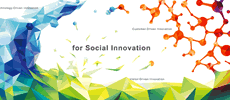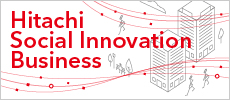Railway SystemsGreen Energy & Mobility
1. VERTICS Next-generation Wireless Communication System for Railways
Wireless communication between ground equipment and vehicle equipment in railway systems has traditionally involved the development of a dedicated communication infrastructure for railways, which was primarily owned and maintained by railway operators. As a result, it has been difficult to readily apply the latest communication technologies, and this poses a challenge to the ongoing digital transformation (DX) of railway systems and railway operations. Furthermore, securing maintenance personnel for proprietary communication systems has become an increasingly serious challenge due to the declining workforce.
To address this challenge, Hitachi has developed the Versatile Enhanced Radio and Train Integrative Communication System (VERTICS) as a solution. The purpose of this system is to utilize public wireless networks and other general-purpose wireless technologies for communication between ground and vehicle equipment, as well as between central and field equipment on the ground, thereby enabling highly reliable, high-capacity wireless communication at low introduction and operational costs. The main features of this system are as follows:
- Redundancy and high reliability of communication paths can be achieved using multiple public wireless communication carriers and general-purpose wireless devices.
- Communication control features such as transmission priority control and continuous transmission/retransmission control are available for transmitted data.
- Wireless systems that were previously built for each application can be integrated into a single common wireless system.
By applying this system, data communications essential for the DX of railway operations such as control data transmission for autonomous train operation, video transmission for monitoring the front of the vehicles, and maintenance data collection can be achieved with high reliability and low cost.
[01]Schematic of VERTICS Next-generation Communication System![[01]Schematic of VERTICS Next-generation Communication System](/rev/archive/2025/01/07/image/fig_01.png) VPN: virtual private network
VPN: virtual private network
2. Efforts Related to Forward Obstacle Detection System
The forward obstacle detection system consists of a stereo camera, a monocular camera, Light Detection and Ranging (LiDAR), processing units, and other components, all of which work together to enable the real-time monitoring of obstacles on the track on the train driver’s behalf. They can also recognize railway signals and signs using artificial intelligence (AI) and provide the recognized results to other devices. These systems offer some of the technologies necessary to achieve autonomous operation on tracks with level crossings, such as general existing and local railway lines. As securing train drivers becomes increasingly difficult due to the declining population, the realization of autonomous operation can be expected to ensure operational continuity and reduce train operation costs.
Hitachi is collaborating with multiple railway operators in Japan to develop forward monitoring systems by equipping railway vehicles, including commercial trains, with these systems. Evaluation is proceeding daily based on more than 4,800km worth of accumulated data collected so far. Hitachi is also conducting demonstration tests for autonomous operation overseas. Through the development of forward monitoring systems, Hitachi aims to contribute to the advancement of the railway industry.
[02]Processing Flow of the Forward Monitoring System![[02]Processing Flow of the Forward Monitoring System](/rev/archive/2025/01/07/image/fig_02.png) GNSS: global navigation satellite system
GNSS: global navigation satellite system
3. Railway Maintenance DX Initiatives
The declining workforce has become a major issue in Japan’s railway industry due to difficulties in securing the personnel involved in railway operations. This has a particularly significant effect on on-site tasks such as railway maintenance, which rely heavily on human workers. On the other hand, the environment of railway maintenance makes full automation difficult. The challenge lies in how to enhance human-centered on-site capabilities through DX while achieving advanced on-site work, quality maintenance, safety, security, and efficiency.
Hitachi's Kasado Works, which manufactures rolling stock, faces similar challenges. It has been engaged in various DX initiatives to reform on-site operations, including efforts to improve through manufacturing process visualization and the 3D conversion of design drawings. Hitachi provides the successful DX case from its Kasado Works as a business reform support service for railway operators called “Train Maintenance DX as a Service.”
In the future, Hitachi aims to share digitalized data from vehicle manufacturing and maintenance processes across the entire railway industry, and by utilizing technologies such as AI, contribute not only to the optimization of individual railway operators but also to the optimization of the industry as a whole.
[03]Train Maintenance DX as a Service![[03]Train Maintenance DX as a Service](/rev/archive/2025/01/07/image/fig_03.png) KPI: key performance indicator
KPI: key performance indicator
3D: three dimensions
4. Sendai City Transportation Bureau
New Namboku Line 3000 Series Train Car
Hitachi received an order from the Sendai City Transportation Bureau for the Namboku Line's new 3000 series train cars in March 2020. The “green” line color, which has been beloved for a long time in the 1000N series train cars to symbolize the “City of Trees” is continually used and the design has been decided by the voting of residents along the railway line after the consideration of three distinct design proposals under the concept of evolution from the traditional Namboku Line train cars. For the interior, Hitachi has adopted a design that matches the characteristics of the line, including seat upholstery patterns inspired by the avenue Jozenji-dori’s rows of zelkova trees.
In addition to the automatic train control/operation (ATC/O) system, which consolidates and miniaturizes related equipment based on the functions of the 1000N series, the 3000 series also incorporates new features. These include redundant main circuit devices (control devices, filter reactors, main motors), a vehicle information management system (Synaptra) with operational control functions and monitoring capabilities for onboard equipment, and a passenger information system (PIS) that provides clear guidance through a large LCD display. These systems were newly supplied by Hitachi.
The first trainset was put into commercial service in October 2024 and subsequent trainsets will be delivered and put into operation sequentially from the 2025 fiscal year onward.
5. Hankyu Corporation
2300 and 2000 Series Vehicle Bodies
Hitachi manufactured the new 2300 series limited express train car for Hankyu Railway’s Kyoto Line and the new 2000 series commuter train car for the Kobe and Takarazuka Lines for Hankyu Corporation.
The development concept is “a new Hankyu style that prioritizes safety, comfort, and environmental consciousness.” While preserving the traditional maroon-colored body, wood-grain decorative panels, and golden olive-colored seats that define the “Hankyu train” image, the design also incorporates curved front windows to create a sense of speed.
Inside the train cars, various barrier-free enhancements have been made to ensure a comfortable travel environment for all passengers. These include expanding the wheelchair space in the lead cars, lowering the height of hand straps, and changing the strap colors to accommodate diverse color vision needs.
Additionally, for the Kyoto Line’s 2300 series limited express train car, the concept is to transform everyday “travel time” into “personal time” within a private space. To enhance passenger comfort, the seating arrangement has been configured into three rows (two plus one), and a special car with wider seat cushions and more legroom compared to standard cars is positioned as the fourth car from the Osaka-bound end.
The 2300 series entered service on July 21st, 2024. The 2000 series will also be gradually introduced.
6. West Japan Railway Company
Traction System for 273 Series Express DC Electric Train
West Japan Railway Company has been operating the 381 series trains, which were introduced during the Japanese National Railways era, for the “Yakumo” limited express on the Hakubi Line connecting the San’in and Sanyo regions. However, to further improve safety, passenger services, convenience, and ride comfort, the company has developed and introduced the new 273 series express DC electric trains (hereinafter referred to as “273 series”).
To accommodate the reduced installation space resulting from the adoption of a tilting train body in the 273 series traction system, the cooling structure of the traction motor was redesigned. Additionally, the train control system, including both the variable voltage variable frequency (VVVF) inverter and the static auxiliary power supply unit, incorporate Full SiC (silicon carbide) modules in the power unit, achieving a more compact and lightweight design while enhancing energy efficiency. Furthermore, to ensure stable train control even in the steep gradient sections of the Hakubi Line, which is the primary operational route, the system was developed with a focus on implementing high-precision speed sensorless control and highly reliable reverse start control.
The 273 series began operation as the “Yakumo” in April 2024, and a total of 11 trainsets(44cars), from Y1 to Y11, have been introduced into service.

![[04]3000 Series Exterior and Interior](/rev/archive/2025/01/07/image/fig_04.png)
![[05]Hankyu Corporation 2300 Series Train Cars](/rev/archive/2025/01/07/image/fig_05.png)
![[06]West Japan Railway Company 273 Series Limited Express Direct Current Train Cars](/rev/archive/2025/01/07/image/fig_06.png)


